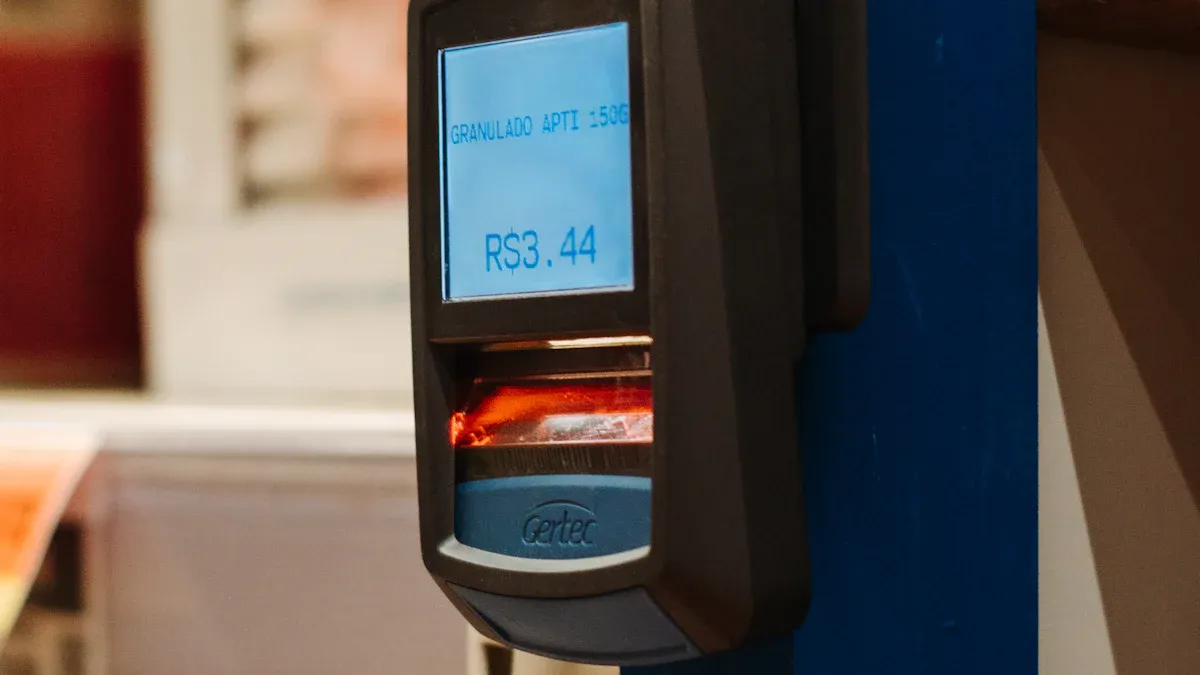
When you design an electronic shelf label, you tap into a rapidly expanding market. In 2024, the global market for digital shelf labels reached $1.52 billion, with projections suggesting growth to $5.84 billion by 2033. You can achieve accurate pricing and paper-free operations by replacing manual tags with electronic shelf labels. Retailers using solutions like the ESL Gateway AP and ESL Price Tag in Esl Retail report cost savings, with automation reducing labor and minimizing errors. Digital automation also accelerates updates, making your design an electronic shelf label system both efficient and reliable.
Essential Components to Design an Electronic Shelf Label

Hardware Requirements
You need to select the right hardware to ensure your electronic shelf label system operates efficiently. The following table outlines the essential components you should include:
| Component | Description |
|---|---|
| Label management software | Manages system configuration, label properties, and stores the database for prices. |
| Communication station | Transmits data from management software to labels using wireless methods, mainly radio frequency. |
| Terminal display | Receives data and displays the configured price based on received instructions. |
| E-ink display | Shows the price and product information on the shelf label. |
| Radio | Enables wireless communication, often using RF modules. |
| Microcontroller | Acts as the processing unit, managing operations and communication. |
| Batteries | Powers the labels, allowing independent operation. |
Most electronic shelf labels use e-paper displays for clear, low-power digital readouts. You should choose microcontrollers that can handle wireless communication and display control. Wireless modules, such as RF or Bluetooth, support reliable data transfer. Batteries provide long-lasting power, reducing the need for frequent maintenance.
Software Essentials
You need robust software to manage your electronic shelf label network and digital inventory. The right platform streamlines updates, controls pricing, and integrates with your inventory system. Here are some leading software solutions:
| Software Name | Description | Key Features |
|---|---|---|
| AIMS | Manages stock levels and updates product information. | Optimizes inventory, prevents shortages, and enables efficient control. |
| sepioo | IoT platform for central administration. | Supports fast updates, real-time communication, modular integration. |
| fbOS | Basic ESL control software. | Template generator, interface integration. |
| Jeegy | Advanced management for large stores. | Automates price changes, links e-paper tags, maps inventory. |
Tip: Look for software that offers real-time display updates, centralized control, and inventory management. These features help you reduce errors, automate promotions, and improve customer satisfaction.
Connectivity Choices
You must select a wireless protocol that balances cost, reliability, and energy efficiency. The table below compares popular options for electronic shelf label connectivity:
| Protocol | Advantages | Disadvantages |
|---|---|---|
| BLE5.0 | High speed, low power, secure, supports firmware upgrades. | Needs compatible hardware, limited range in some settings. |
| 433MHz | Low cost, simple setup. | Poor security, unreliable communication. |
| RFID 2.4G | Moderate cost, reasonable range. | Limited anti-interference, fewer channels. |
| ZigBee | Low power, good for mesh networks. | Low speed, limited distance, higher latency. |
| WiFi | High data rate, widely available. | High power use, higher cost, complex coding, not ideal for low-power digital solutions. |
Choose BLE5.0 or ZigBee for most digital inventory applications. These protocols offer low power consumption and reliable performance, which are critical for large-scale inventory management.
Selecting Affordable Parts for Electronic Shelf Labels
Budget-Friendly Display Options
You can lower costs by choosing display technologies that balance durability and performance. E-ink displays stand out for electronic shelf labels because they offer a lifespan of 5 to 7 years, require minimal maintenance, and withstand millions of updates. These displays also feature high IP ratings, such as IP65 or IP67, which means they resist dust and water. The table below highlights key features of e-ink technology:
| Feature | E-Ink Technology |
|---|---|
| Lifespan | 5 to 7 years or more |
| Maintenance Needs | Minimal |
| Battery Life | Long |
| Durability | Millions of updates |
| Weather Resistance | High (IP65/IP67) |
When you select displays, always request samples to check readability and integration with your inventory tracking system.
Cost-Effective Microcontrollers and Chips
You should evaluate microcontrollers and chips based on quality, compliance, and supplier reliability. Look for ISO 9001 certification to ensure strong quality management. Compliance with RoHS and REACH demonstrates environmental responsibility. For wireless electronic shelf labels, CE, FCC, or SRRC approvals are essential, depending on your market. Conduct factory audits or request third-party inspections to verify SMT assembly lines and testing equipment. Reliable suppliers provide performance data, such as on-time delivery rates above 95% and fast response times. Customer reviews can reveal how well suppliers handle after-sales support and defect resolution.
Low-Power and Efficient Energy Solutions
Selecting the right energy solution reduces operational costs and supports sustainable inventory tracking. E-paper displays only use energy during updates, which makes them ideal for digital inventory systems with infrequent changes. Batteries in e-paper shelf labels can last up to ten years due to efficient drive circuits. In contrast, LCD tags require constant power and may need battery replacements every one to two years, increasing costs. E-paper technology also supports ESG principles by reducing paper waste. The table below compares battery life and replacement costs:
| Technology Type | Battery Life | Replacement Cost |
|---|---|---|
| E-paper | 5 to 7 years | Lower |
| LCD | 1 to 2 years | Higher |
Tip: Choose e-paper for long battery life and minimal maintenance, especially if your inventory updates are not frequent.
Step-by-Step Guide to Build and Integrate Electronic Shelf Labels

Assembly and Installation Process
You can achieve a smooth installation of electronic shelf labels by following a structured approach. Begin by preparing your shelves and ensuring you have all necessary mounting accessories. Use the following steps to guide your assembly:
- Secure the rails to the shelf edge with fasteners suitable for the shelf material. This step provides a stable foundation for your labels.
- Clip the shelf edge labels onto the rails, aligning them with the grooves or attachment points designed for your system.
- Adjust the rails using an angle adjuster to optimize visibility for customers.
- Align the label clips with the slots on your digital tags and snap them into place.
- For a stronger grip, tighten a clamp around the label and the mounting surface.
- Assemble any display stands according to the instructions, then attach the label using built-in clips or screws.
- For specialized environments, use accessories such as peg hook brackets for pegboards or pole-to-ice mounts for cold storage.
Tip: Always double-check the alignment and stability of each label before moving to the next shelf. This practice ensures a professional appearance and reduces the risk of accidental dislodging.
During installation, you may encounter several challenges. The table below outlines common issues and their descriptions:
| Challenge | Description |
|---|---|
| Initial Setup Costs | Upfront investment in hardware, software, and installation can be significant for small stores. |
| Staff Training and Adaptation | Employees may need comprehensive training to manage the new system effectively. |
| Technical Glitches and Maintenance | Connectivity issues and display errors require ongoing technical support. |
| Connectivity and Power Requirements | Poor network coverage or frequent battery replacement can disrupt operations. |
| Aesthetic Concerns | Digital displays may not match the traditional look of some retail environments. |
| Regulatory Compliance and Accuracy | Accurate and timely updates are essential to avoid customer dissatisfaction and legal issues. |
Setting Up Wireless Communication
You must configure wireless communication to ensure reliable updates and seamless integration with your inventory system. Follow these best practices to set up your network:
- Access your network dashboard and select the access point you want to enable for electronic shelf labels.
- Activate the electronic shelf label bridge feature in the settings.
- Choose the vendor type and the specific solution that matches your hardware.
- Disable 2.4 GHz radios on access points to prevent interference and improve update speed.
- Assign a separate VLAN for your labels, distinct from the VLAN used for general wireless services. This separation simplifies management and troubleshooting.
The table below summarizes the key steps for wireless setup:
| Step | Description |
|---|---|
| 1 | Go to the network dashboard and select the relevant access point. |
| 2 | Enable the access point for ESL operation. |
| 3 | Activate the ESL bridge feature. |
| 4 | Select the vendor and solution type. |
Note: Proper network segmentation and interference management help maintain consistent performance for your digital inventory system.
Testing and Troubleshooting
After installation and network setup, you need to test your electronic shelf labels to ensure reliable operation. Use the following checklist to identify and resolve common issues:
- Check signal strength throughout your store using a wireless signal tester. Identify and address any dead zones or weak spots.
- Inspect network hardware. Confirm that all gateway access points have power and are correctly placed. Reboot devices if necessary.
- Review device pairing. Make sure each label pairs with the management software. Unpair and re-pair any unresponsive units.
- Monitor for wireless interference. Adjust channel settings if you detect sources of interference.
You may encounter specific errors during operation. The table below lists common error types, likely causes, and recommended actions:
| Error Type | Likely Cause | Recommended Action |
|---|---|---|
| Blank Screen | Dead battery | Replace battery |
| Frozen Display | Software glitch | Reset or reinitialize label |
| Incorrect Data | Sync failure | Manual refresh, check database |
Tip: Regularly walk the aisles and monitor your inventory system for anomalies. Early detection of issues helps you maintain a reliable and efficient electronic solution.
Optimizing Electronic Shelf Labels for Long-Term Cost Savings
Reducing Maintenance and Labor Costs
You can lower your operational expenses by using electronic shelf labels that automate price changes and inventory management. Digital updates eliminate the need for staff to walk the aisles and replace paper tags. This shift saves thousands of hours each year. You also reduce the risk of pricing errors, which means fewer customer complaints and less time spent resolving disputes. When you use electronic shelf labels, you decrease your reliance on paper and ink, which further cuts costs. Effective onboarding and streamlined training help your team adapt quickly, so you spend less time and money on training new hires.
Tip: Automate as many inventory and pricing tasks as possible to maximize labor savings and improve accurate stock tracking.
Streamlining Software Updates and Management
Centralized management software allows you to update all your electronic shelf labels at once. This feature eliminates manual edits and ensures that every label displays the correct price. You connect your labels directly to your store’s database, which guarantees accurate stock tracking and instant updates. The system supports various sales tactics, such as flash deals and price bundling, giving you flexibility in your promotions. The table below highlights the main benefits of streamlined software management:
| Feature | Benefit |
|---|---|
| Centralized Updates | Simultaneous changes across all labels |
| Cost Savings | No need for printing or disposing of paper signage |
| Error Reduction | Fewer manual mistakes during inventory and pricing updates |
Note: Regular software updates keep your inventory system secure and efficient.
Minimizing Energy Consumption
Electronic shelf labels use very little energy, which helps you save on long-term costs. Each update requires only a small amount of power, and the system operates at low voltage. E-paper displays only draw energy during updates, so batteries last for years. You also help the environment by reducing waste from paper tags. Many retailers now choose low-energy displays and recyclable materials to meet stricter energy standards. Some stores even use renewable energy sources for their in-store devices. These strategies support sustainability and lower your overall energy expenses.
Remember: Efficient energy use not only reduces costs but also supports your environmental goals.
Avoiding Pitfalls When You Design an Electronic Shelf Label Solution
Preventing Compatibility and Integration Issues
You need to ensure your electronic shelf labels work seamlessly with your existing inventory and point-of-sale systems. Many retailers face challenges when older inventory or POS systems lack modern APIs or integration features. This can lead to data mismatches and operational delays. You can address these issues by:
- Using middleware or custom adapters to connect legacy and modern systems.
- Verifying that price changes update simultaneously across your electronic shelf labels, POS, and online channels.
- Testing integration with your inventory management software before full deployment.
Note: Seamless integration reduces errors and keeps your digital pricing accurate across all platforms.
Managing Scalability and Expansion
As your store grows, you must plan for the expansion of your electronic shelf label system. High initial investment and infrastructure upgrades can be barriers, especially for small retailers. Reliable wireless networks are essential for real-time updates. Security risks, such as data breaches, also increase as you scale. To manage these challenges:
- Choose scalable solutions that fit your current needs but allow for future growth.
- Ensure your electronic shelf labels integrate with your existing inventory and IT systems.
- Leverage advanced technologies to improve reliability and security.
Here are common scalability challenges and solutions:
| Challenge | Solution |
|---|---|
| High initial investment | Select affordable, scalable options |
| Technical complexities | Use reliable wireless and IT infrastructure |
| Integration difficulties | Work with vendors skilled in inventory systems |
Choosing Reliable Suppliers and Partners
Selecting reliable suppliers and partners is critical for long-term success. You should evaluate each supplier based on several criteria:
- In-store optimization
- Scalability for future expansion
- Future-proof technology
- Compatibility with your inventory and digital systems
- Total cost of ownership
- Compliance with industry standards
- Security features
- Label sizes and color options
- Variety of electronic shelf labels
- Battery performance
You should also consider battery life, display visibility, ease of integration, durability, and flexible pricing. Reliable partners help you avoid costly mistakes and ensure your inventory system remains efficient.
Tip: Always request detailed product specifications and test samples before making a final decision.
| Challenge | Description |
|---|---|
| High initial costs | Setting up electronic shelf labels can be expensive, particularly in larger retail environments. |
| Ongoing maintenance | Electronic labels may require repairs or replacements over time. |
| User technology adoption | Some customers may struggle to read digital shelf tags if they lack tech familiarity. |
You can build a cost-effective electronic shelf label solution by focusing on smart component selection and efficient inventory integration. Start with a small-scale pilot in a high-traffic area, train your staff, and connect your electronic system to your digital inventory and POS platforms. Real-time pricing updates, reduced labor, and improved pricing accuracy deliver long-term savings. The table below highlights the main benefits:
| Benefit | Description |
|---|---|
| Real-time pricing updates | Immediate changes for accurate digital inventory control |
| Reduced labor costs | Less manual work for price and inventory management |
| Improved pricing accuracy | Fewer errors, better customer trust |
Consult experienced solution providers to future-proof your electronic inventory strategy.
FAQ
What is the lifespan of an electronic shelf label?
You can expect most electronic shelf labels to last between five and seven years. E-paper displays require minimal maintenance and use energy only during updates. This long lifespan helps you reduce replacement costs and maintain a reliable pricing system.
How do you update prices on digital shelf labels?
You update prices using centralized management software. The system connects to your inventory database and pushes new prices to each label. This process ensures accurate pricing and eliminates manual changes, saving you time and reducing errors.
Can electronic shelf labels integrate with existing inventory systems?
You can integrate electronic shelf labels with most modern inventory systems. Many solutions offer APIs or middleware for seamless data exchange. Always verify compatibility before deployment to avoid integration issues and ensure smooth operation.
What wireless technology works best for electronic shelf labels?
You should consider BLE5.0 or ZigBee for electronic shelf labels. These protocols offer low power consumption and reliable communication. Your choice depends on store size, infrastructure, and specific requirements for speed and range.
Are electronic shelf labels suitable for small retailers?
You can use electronic shelf labels in small stores. Start with a pilot project to test the system. Choose scalable solutions that fit your budget and allow for future expansion as your business grows.


